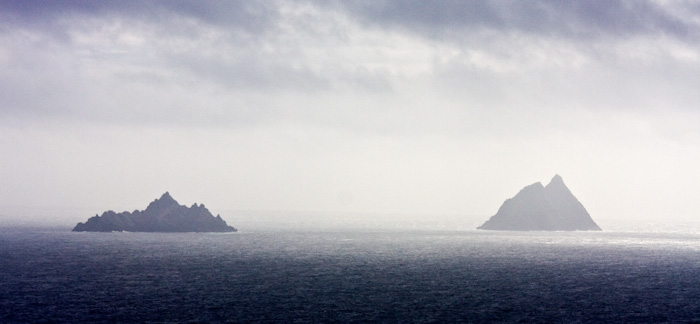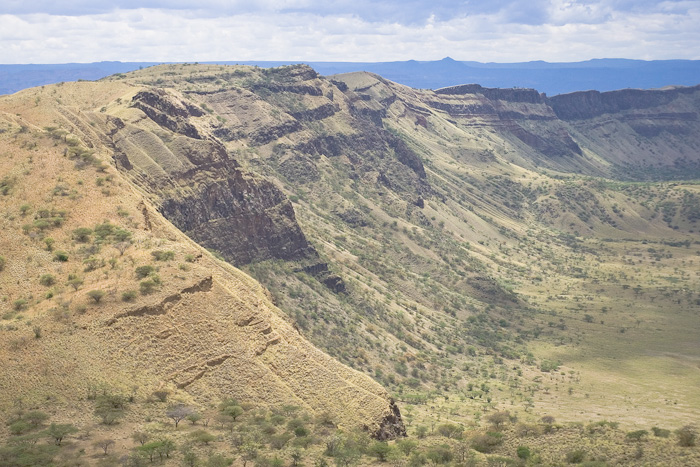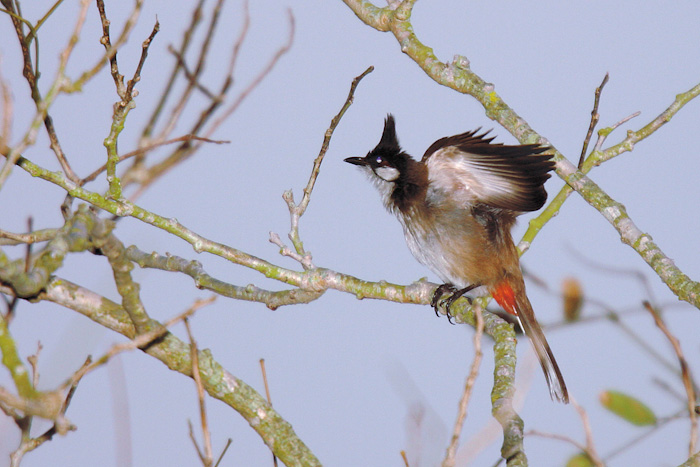by David Clarke | Sep 14, 2012 | All, Places, USA

Looking south from the 86th floor of the Empire State building, with the new Freedom Tower rising from Ground Zero and a storm drifting through Newark across the Hudson River. If you look carefully, you can see the Statue of Liberty at the left end of the upper of the two islands in the distance.
Canon 40D with Canon EFS 10-22mm lens at 10mm ISO200 f5 1/1500
by David Clarke | Sep 12, 2012 | All, Places

The Skellig Rocks are two large Devonian Sandstone islands that rise out of the Atlantic Ocean some 12 km south east of Valencia Island on the Ring of Kerry, South West Ireland. The larger of the two (to the right), Skellig Michael, rises 230 metres above sea level. Perched on a promontory near the top are ruins of a monastery dating back to the 6th century which was inhabited by monks for over 200 years. It’s hard to even imagine the conditions there in those days, especially when you factor in the cold, the wind, the rain and the isolation, although the latter is presumably what they were after. Both islands are home to huge colonies of seabirds including some 27,000 pairs of gannets on Small Skellig.
On our trip to Ireland, we had every intention of visiting Skellig Michael (Small Skellig is closed to the public) but the weather got the better of us. This shot was the view from Valencia Island on the afternoon we arrived, with the mist bearing down on the coast, a mist that remained for the rest of our stay and which precluded us even seeing the islands again. Needless to say, the mist, together with rough seas, meant all trips were cancelled. Another time, perhaps.
Canon 40D with Canon 70-200 f4L IS at 121mm; ISO200 f8 1/1000
by David Clarke | Sep 10, 2012 | All, Italy, People

A favourite shot of grandson Frank when he was around ten months old (he’s now just turned eight and he still loves passion fruit!
Canon EOS 1D MkII with Canon 28-70mmL f2.8 lens at 62mm. ISO 100 1/50 at f6.3
by David Clarke | Sep 8, 2012 | All, Kenya, Places

If you like remote, this place is remote! Silali is a volcano situated in the northern Kenya rift valley, which means it’s somewhat off the beaten track!
With a summit elevation of 1578m (5013 ft) above sea level, it has a spectacular summit caldera of 8 × 5 km. with summit walls, as shown in this shot, of up to 300m high. The summit is 600-800 m above the surrounding rift valley floor. Silali was formed some 63000 years ago and had its main eruptions around 7050 – 5050 BC, although there is still geothermal activity there with some eruptions possibly having happened in the last few hundred years.
This shot was taken from a Cessna 4-seater on a trip north-west from Nanyuki down into the rift valley to check out Silali. Although we didn’t fly high enough to get an overall view, we did fly up the outside walls, down into the crater and up the other side; a truly amazing flight.
Much of the above information was gleaned from the site volcano live and there is more interesting stuff at theGlobal Volcanism Program
Canon EOS 1DMkII with Canon 28-70L f2.8 lens at 55m. ISO200 1/5000 at f2.8
by David Clarke | Sep 6, 2012 | All, Birds, Hong Kong

This fellow was one of several bulbuls that frequented the trees outside the balcony of our apartment in Hong Kong. I took this shot some years ago with my first digital slr on a misty day in the spring. The bird was at least 40 feet away and even using a doubler on the 300mm lens, he was quite small – the image is a little cropped. In order to get sufficient light, I used a projection device on the flash gun.
According to Craig Robson’s Birds of South East Asia (pub. New Holland) ‘the Red-Whiskered Bulbul in the adult has a tall erect black crest, black moustachial line, whitish ear-coverts and underparts and red ear-patch and undertail coverts. The juvenile is brown tinged overall, crest shorter, red ear-patch lacking, undertail parts pinker. Resident from India & Tibet eastwards and a common resident in SE Asia except Peninsula Malaysia and Singapore. Size of adult: 18-20.5 cm’
The Red-Whiskered Bulbul is also known as the Crested Bulbul (Pycnonotus jocosus)
Canon EOS D60 with Canon 300mm f2.8L IS lens and Canon x2 extender; ISO 200 f11 1/200, projection flash.








